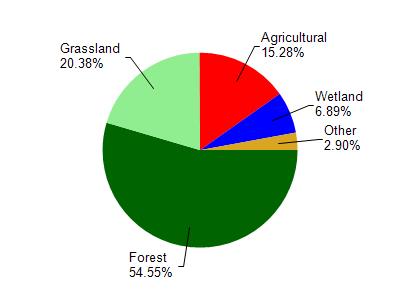Iowa
No
No
No
Fish and Aquatic Life
Historical Description
Source: 1968, Surface Water Resources of Iowa County,WI: WI-DNR Cox Hollow Lake, T6N, R4E, Section 10, 11
Cox Hollow Lake is an impoundment of the headwaters of Mill Creek whose primary water sources are seepage and runoff. It lies wholly within the 4,600-acre Governor Dodge State Park and was constructed in 1958. The primary use is for wildlife and recreation but it also serves as a flood control device in conjunction with the Twin Parks Watershed flood control project on the Mill Creek system. There is a 25-foot high dam which maintains about a 20-foot head throughout the year. The fishery was created by stocking. Originally it was managed for largemouth bass, northern pike and bluegills but during the past few years its fishery has deteriorated to largemouth bass and a large population of stunted bluegills. Other species which are present include white suckers, black bullheads and various forage fishes. Currently, there is a serious weed problem which interferes with recreational use. For the past three years the Bureau of Research has conducted a study involving the use of aero-hydraulic guns to circulate seasonally stratified waters and follow limnological and biological changes which have resulted. Game assets include a sizable population of muskrats and a few beaver on a small tributary. Waterfowl are especially common during the spring and fall migrations and include mallards, blue- winged teal, coots, wood ducks and Canada geese. Being located in a state park a large campground adjoins it and a guarded swimming beach has been provided. There is launching site for trailered boats with a large parking lot. In general access appears to be adequate for this body of water. Motor boating is prohibited.
Surface Acres = 96.0, S.D.F. = 2.4, Maximum Depth = 29 feet
Date 1968
Author Surface Water Inventory Of Wisconsin
General Condition
Governor Dodge State Park Cox Hollow Beach was assessed for the 2018 listing cycle; E. coli data sample data were clearly below the 2018 WisCALM listing thresholds for the Recreation use. This beach was meeting this designated use and was not considered impaired.
Date 2017
Author Ashley Beranek
Impaired Waters
Cox Hollow Lake (WBIC 1246500) was placed on the impaired waters list for excess algal growth in 2016. The 2018 assessments showed continued excess algal growth; new chlorophyll-a sample data exceeded the 2018 WisCALM listing thresholds for the Recreation use. Total phosphorus data were clearly below the Recreation use and Fish and Aquatic Life use listing thresholds. Based on the most updated information, no change in the existing impaired waters listing was needed.
Date 2017
Author Ashley Beranek
Impaired Waters
Cox Hollow Lake (WBIC 1246500) was assessed during the 2016 listing cycle; chlorophyll sample data exceed 2016 WisCALM listing thresholds for the Recreation use, however, total phosphorus data do not exceed REC thresholds. Total phosphorus and chlorophyll data do not exceed Fish and Aquatic Life thresholds.
Date 2015
Author Aaron Larson
Condition
Wisconsin has over 84,000 miles of streams, 15,000 lakes and milllions of acres of wetlands. Assessing the condition of this vast amount of water is challenging. The state's water monitoring program uses a media-based, cross-program approach to analyze water condition. An updated monitoring strategy (2015-2020) is now available. Compliance with Clean Water Act fishable, swimmable standards are located in the Executive Summary of Water Condition in 2018. See also the 'monitoring and projects' tab.
Reports
Management Goals
Wisconsin's Water Quality Standards provide qualitative and quantitative goals for waters that are protective of Fishable, Swimmable conditions [Learn more]. Waters that do not meet water quality standards are considered impaired and restoration actions are planned and carried out until the water is once again fishable and swimmable
Management goals can include creation or implementation of a Total Maximum Daily Load analysis, a Nine Key Element Plan, or other restoration work, education and outreach and more. If specific recommendations exist for this water, they will be displayed below online.
Monitoring
Monitoring the condition of a river, stream, or lake includes gathering physical, chemical, biological, and habitat data. Comprehensive studies often gather all these parameters in great detail, while lighter assessment events will involve sampling physical, chemical and biological data such as macroinvertebrates. Aquatic macroinvertebrates and fish communities integrate watershed or catchment condition, providing great insight into overall ecosystem health. Chemical and habitat parameters tell researchers more about human induced problems including contaminated runoff, point source dischargers, or habitat issues that foster or limit the potential of aquatic communities to thrive in a given area. Wisconsin's Water Monitoring Strategy was recenty updated.
Grants and Management Projects
Monitoring Projects
| WBIC | Official Waterbody Name | Station ID | Station Name | Earliest Fieldwork Date | Latest Fieldwork Date | View Station | View Data |
|---|
| 1246500 | Cox Hollow Lake | 10002731 | Cox Hollow Lake | 8/11/1975 | 9/22/2017 | Map | Data |
| 1246500 | Cox Hollow Lake | 253202 | Cox Hollow Lake - Govenor Dodge State Park Beach | 6/3/2003 | 8/27/2025 | Map | Data |
|

Watershed Characteristics
Cox Hollow Lake is located in the Mill and Blue Mounds Creek watershed which is 186.74 mi². Land use in the watershed is primarily forest (54.60%), grassland (20.40%) and a mix of agricultural (15.30%) and other uses (9.80%). This watershed has 382.87 stream miles, 106.91 lake acres and 6,596.99 wetland acres.
Nonpoint Source Characteristics
This watershed is ranked Medium for runoff impacts on streams, Low for runoff impacts on lakes and High for runoff impacts on groundwater and therefore has an overall rank of High. This value can be used in ranking the watershed or individual waterbodies for grant funding under state and county programs.However, all waters are affected by diffuse pollutant sources regardless of initial water quality. Applications for specific runoff projects under state or county grant programs may be pursued. For more information, go to surface water program grants.